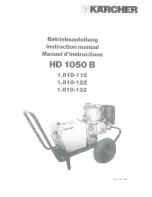
GB 4
PREPARATION OF THE WASHING
1. Sort the laundry according to...
• Type of fabric / care label symbol
Cottons, mixed fibres, easy care/synthetics,
wool, handwash items.
• Colour
Separate coloured and white items. Wash new
coloured articles separately.
• Size
Wash items of different sizes in the same load to
improve washing efficiency and distribution in the
drum.
• Delicates
Wash small items (e.g. nylon stockings, belts etc.)
and items with hooks (e.g. bras) in a cloth bag or
pillow case with zip. Always remove curtain rings
or wash curtains with the rings inside a cotton bag.
2. Empty all pockets
Coins, safety pins etc. can damage your laundry
as well as the appliance drum and tub.
3. Fasteners
Close zips and fasten buttons or hooks; loose
belts or ribbons should be tied together.
Stain removal
• Blood, milk, eggs etc. are generally removed by
the automatic enzyme phase of the programme.
• To remove red wine, coffee, tea, grass and fruit
stains etc. add a stain remover to the main wash
chamber of the detergent dispenser.
• Pre-treat heavily-soiled areas with stain remover
if necessary.
Dyeing and bleaching
• Only use dyes and bleaches that are suitable for
washing machines.
• Follow the Manufacturer’s instructions.
• Plastic and rubber parts of the washing machine
can be stained by dyes or bleaches.
Loading the laundry
1. Open the door.
2. Load the articles one at a time loosely into the
drum, without overfilling. Observe the load sizes
given in the programme chart (overloading the
machine will result in unsatisfactory washing results
and creased laundry).
3. Close the door.
DETERGENTS AND ADDITIVES
Keep detergents and additives in a safe,
dry place out of the reach of children!
The choice of detergent depends on:
- Type of fabric (cottons, easy care/synthetics,
delicate items, wool).
- Colour.
- The wash temperature.
- Degree and type of soiling.
• Use only specific detergents for washing wool and
garments made of microfibres (like sports or
swimwear).
• Any whitish residues on dark fabrics are caused
by insoluble compounds used in phosphate-free
powder detergents. If this occurs, shake or brush
out the fabric or use liquid detergents.
• Use only detergents and additives specifically
produced for domestic washing machines.
• When using descaling agents, dyes or bleaches for
the prewash (if available on your model), make sure
that they are suitable for use in domestic washing
machines. Descalers could contain products which
could damage your washing machine.
• Do not use any solvents (e.g. turpentine,
benzine). Do not machine wash fabrics that have
been treated with solvents or flammable liquids.
• Do not use liquid detergent for the main wash
when having activated the “prewash” option (if
available on your model).
• Do not use liquid detergent when activating the
“Start Delay” function (if available on your
washing machine).
Dosage
Follow the dosage recommendations on the
detergent pack. They depend on:
• degree and type of soiling
• size of wash
- full load: follow the detergent manufacturer’s
instructions;
- half load: 3/4 the amount used for a full load;
- minimum load (about 1 kg): half the amount
used for a full load
If there is no reference to a certain wash load on
the detergent pack: the detergent manufacturers
usually refer their dosing recommendations to
4.5 kg laundry for heavy duty detergent and
2.5 kg laundry for delicate detergent.
• water hardness in your area (ask for information
from your water company). Soft water requires
less detergent than hard water.
Too much detergent can result in excess foam
formation, which reduces washing efficiency.
If the washing machine detects too much foam, it may
prevent spinning, or prolong the programme duration
and increase the water consumption (see also remarks
on foam formation in the “Troubleshooting Guide”).
Insufficient detergent may result in grey laundry and
also calcifies the heating system, drum and hoses.
www.devicemanuals.eu/
Load the articles one at a time loosely into the
Load the articles one at a time loosely into the
erfilling. Observe the load sizes
erfilling. Observe the load sizes
given in the progr
given in the progr
amme chart (overloading the
amme chart (overloading the
machine will resu
machine will resu
lt in unsatisfactory washing results
lt in unsatisfactory washing results
and creased laundry).
and creased laundry).
Close the door.
Close the door.
DETERGENTS AND ADDITIVES
DETERGENTS AND ADDITIVES
ype of fabric (cottons, easy care/synthetics,
ype of fabric (cottons, easy care/synthetics,
detergents for washing wool and
detergents for washing wool and
f microfibres (like sports or
f microfibres (like sports or
ues on dark fabrics are caused
ues on dark fabrics are caused
by insoluble compounds used in phosphate-free
by insoluble compounds used in phosphate-free
Dosage
Dosage
Follow the dosage recommendations on the
Follow the dosage recommendations on the































